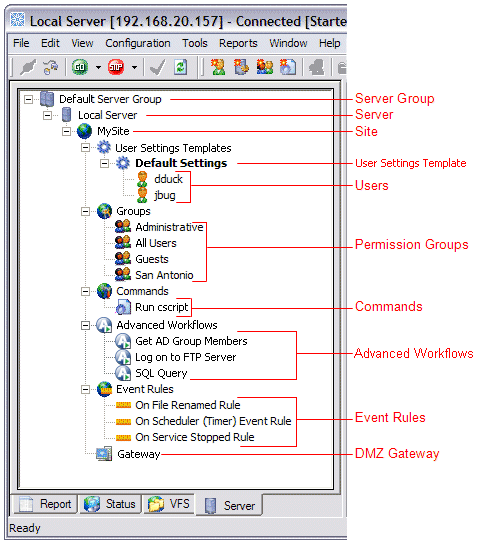EFT Server employs an inheritance hierarchy to manage its Server (In the Administrator, a Server contains the settings for one or more EFT Servers, either locally or remotely.), Site (In the Administrator, a Site is similar to a virtual FTP server bound to one or more IP addresses.), and user settings (Allows you to apply a setting configuration to an entire group of users. Every client account or user must be a member of a Settings Template. Settings Templates exist within a Site and consist of a group of settings used as a template. AKA Settings Level.), and Group (Allows the administrator to define access permissions to files and folders. Just as Settings Templates control access to EFT Server resources such as bandwidth allowances and connectivity privileges, Groups control access to folders. See virtual folders.) permissions. The Administrator displays this hierarchy as a navigation tree in the left pane on the Server tab.
The tree displays each of the EFT Server components that you configure in the Administrator. When you click an item in the tree, the available tabs in the right pane change based on your selection. For example, when you click a Server (e.g., Local Server) on the Server tab in the left pane, the tabs appear in the right pane for configuring that Server. When you click a user on the Server tab in the left pane, the tabs appear in the right pane for configuring that user.
You can create new items and manage items in the tree by right-clicking the tree, or clicking Configuration on the main menu.

Server Group is the topmost level and is an organizational function for multiple groups of Servers; you can add additional Server Groups. (Do not confuse with Permission Groups, below.)
Server represents one or more physical file transfer servers (Server engine) running on the local computer or a remote system. Refer to Server Setup Wizard for more information.
Site is similar to a virtual FTP server bound to one or more IP addresses. Multiple Sites (or hosts) are allowed within each Server. Configuration of Site-wide settings can be inherited at lower levels (in the Settings Template or per user). Each Site contains its own Settings Templates, Users, Groups, Commands, and Event Rules. Refer to Configuring Sites for more information.
User Settings Templates allow you to apply a setting configuration to an entire group of users. Similar to templates or profiles, Settings Templates are a powerful way of organizing users into groupings with predefined settings. The Settings Template specified as the default appears in the tree with bolded text.
Users are individual clients assigned to a Settings Template. Each user can be configured to inherit settings from the Settings Template or have specific settings defined for that particular user.
Groups allow you to define user access permissions to files and folders. Groups are assigned at the Site level. Users' access to folders and files are defined by their assigned Group's permissions.
Commands allow you to configure EFT Server to run executables, batch files, and scripts automatically when specific events occur. You add these commands to Event Rules.
Advanced Workflows allow you to design frequently used scripts, batch files, macros, or any other code-intensive process using an easy drag-and-drop interface and then drop them into an Event Rule.
Event Rules consist of triggering Events, any optional Conditions affecting the Event Rule, and the resulting Actions that are carried out. For details, refer to Introduction to Event Rules.
Gateway allows you to configure the IP address, port, and protocols used to communicate with the DMZ Gateway.